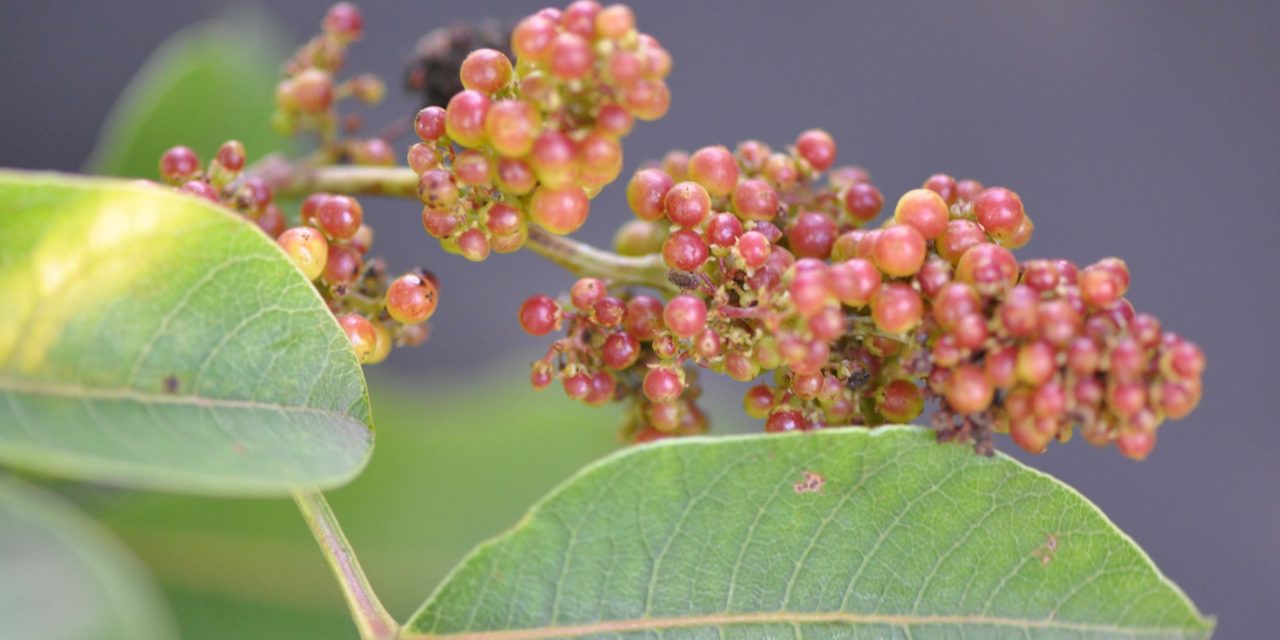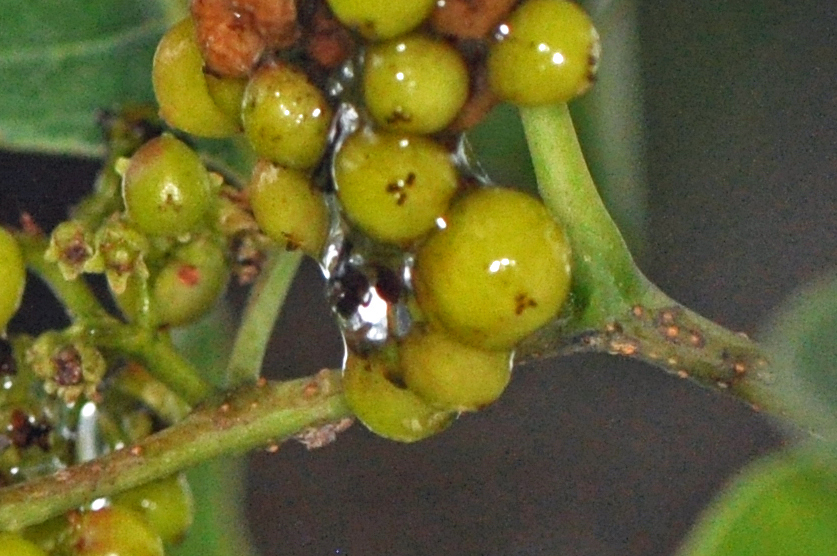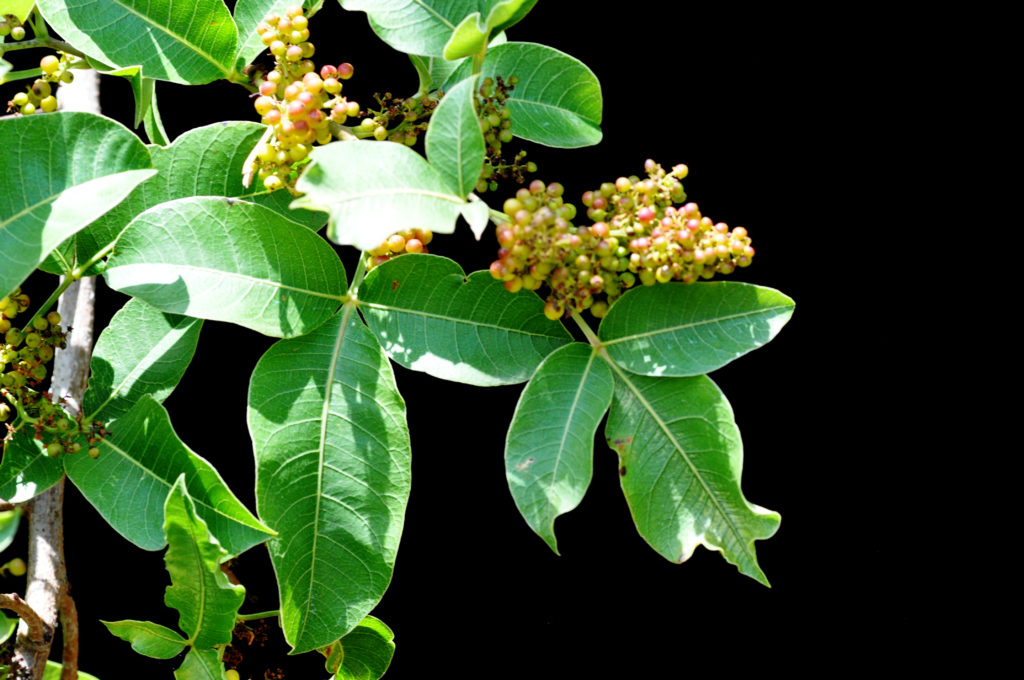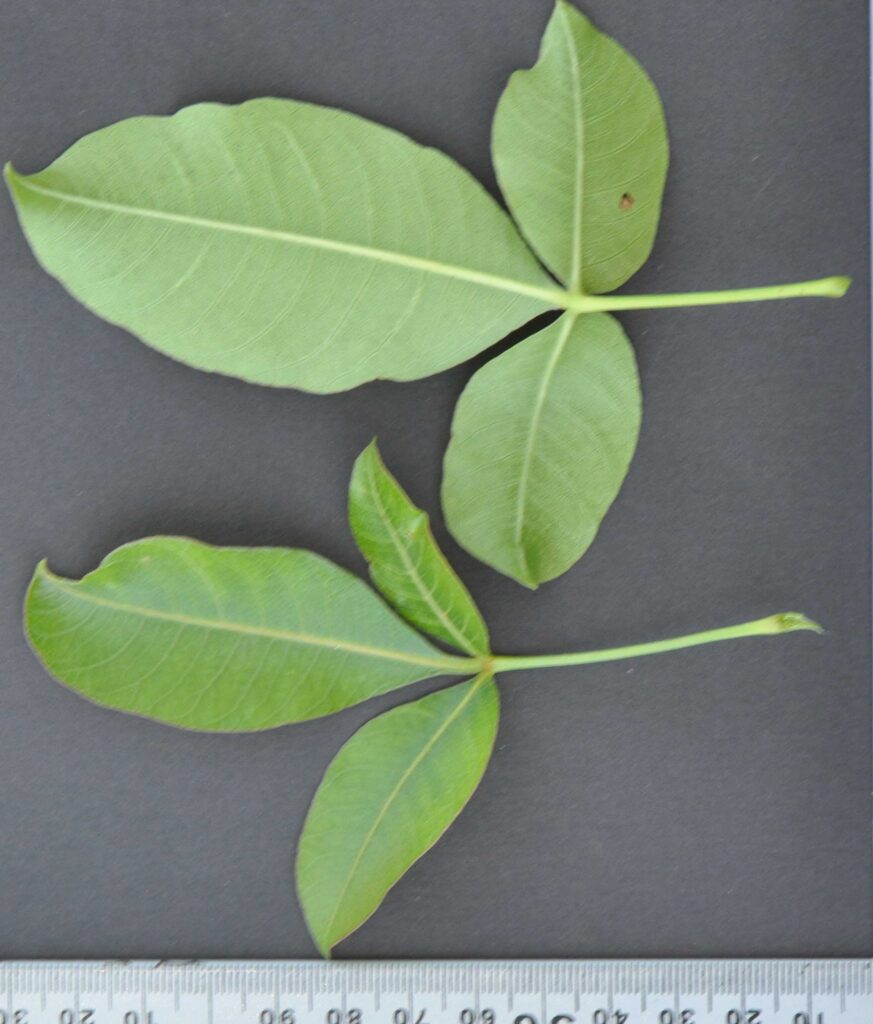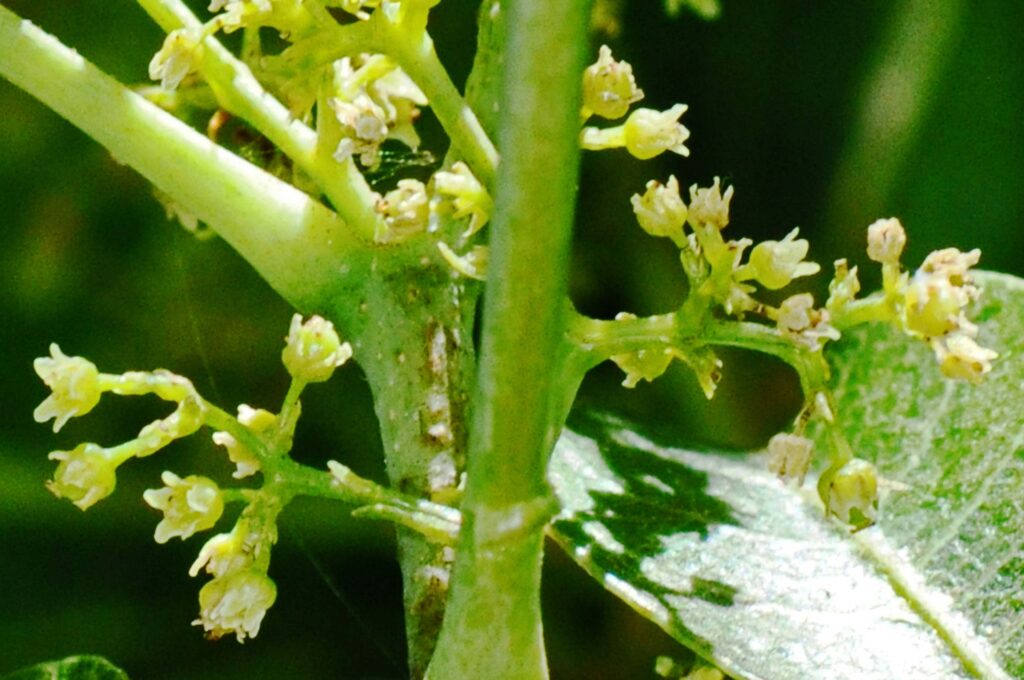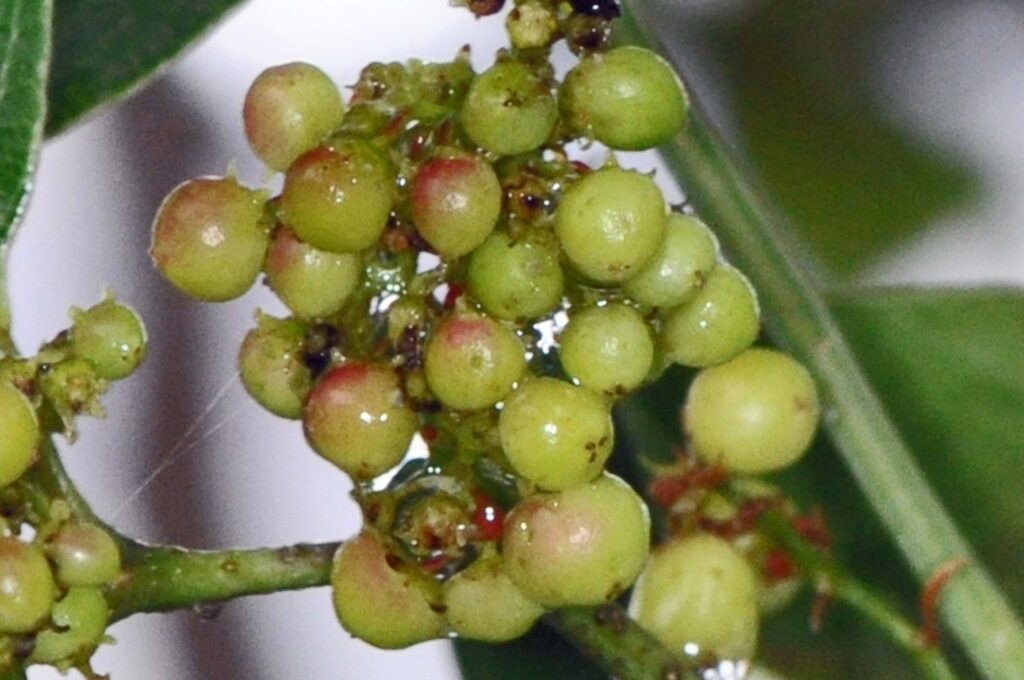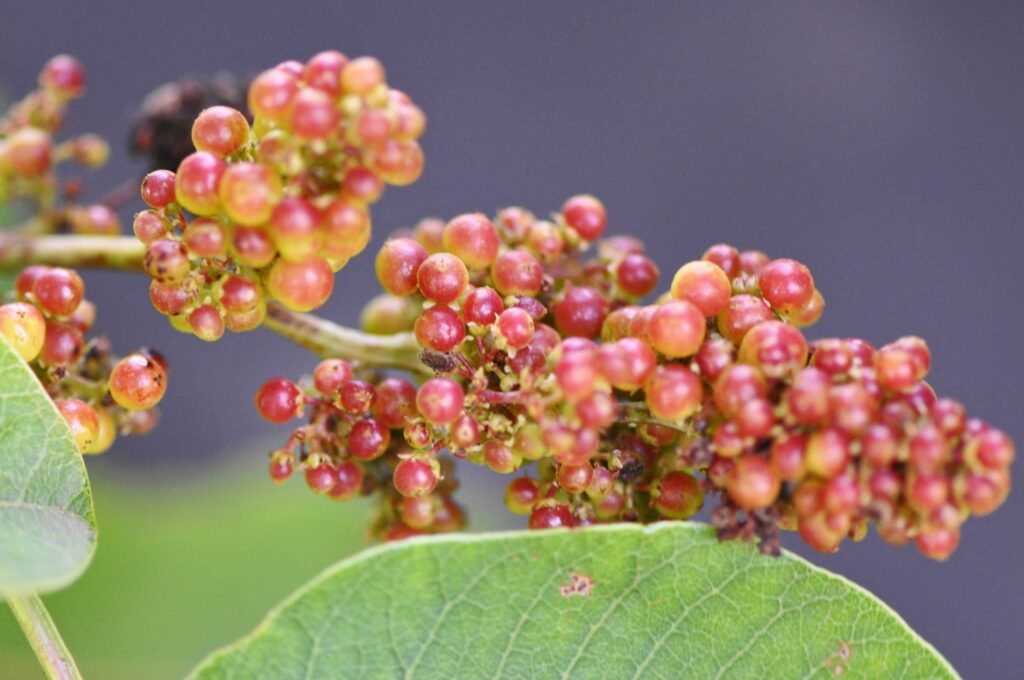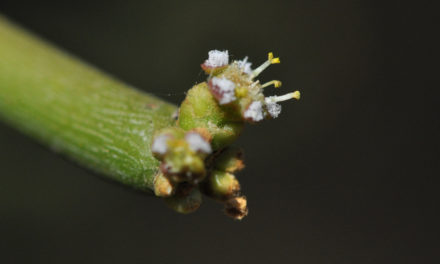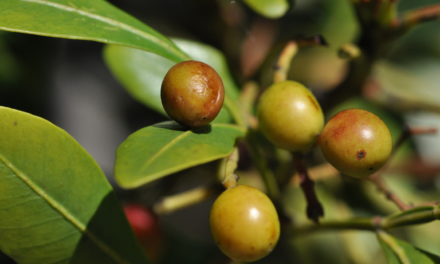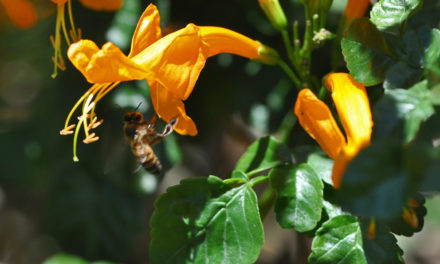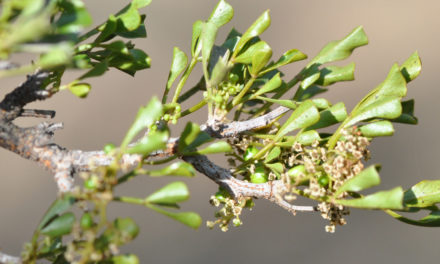General Info – summary
This dioecious plant is usually a shrub. The Tree is small and may reach 4m high. Mature bark is rough and fissured. Hairless, leathery, deciduous and elliptic or obovate Leaves are trifoliate. The leaflets usually lack petiolules. Small unisexual 5-merous Flowers are in panicles. Male: 5 stamens, female with a single pistil + a superior ovary & 3 styles. Each shiny Fruit is a thinly fleshy drupe with one small seed.
Description
Searsia tumulicola var. tumulicola
Previous Names: Rhus culminum, Rhus dura, Rhus synstylica, Rhus tumulicola var. tumulicola.
SA Tree No. 394.3
Common names. (Afr) Hardeblaartaaibos, Hardetaaibos. (Eng) Hard-leaved current, Hard Taaibos, Mountain Scrambling Rhus, Mountain scrambling shrub. (isiZulu) Inhlokoshiyane. (siSwati) Inhlangushane.
Family: Anacardiaceae. (Mango family), which has about 83 genera and 850+ species – including Cashew). About 80 species occur in South Africa. Hunting arrows have been made from straight stems. Resin canals are present and woolly stellate hairs cover all young parts. Leaves lack stipules. They may be deciduous or evergreen and usually alternate. Leaves are simple, trifoliate or digitally compound and imparipinnate. Leaflets are usually opposite. Crushed leaves may smell of turpentine. Trees are monoecious or dioecious with occasional bisexual Flowers. Flowers are small, greenish or yellowish white and usually regular. The Calyx has 4-7 sepals and there are 4-7 Petals. The number of Stamens is the same as, or twice the number of petals and the Anthers are versatile. The superior Ovary has up to 4 locules, each with a single ovule. The 1-5 Styles are free or connate and separated at the base. Fruit is usually an indehiscent fleshy drupe. They provide food in dry areas. They contain a single quick growing Seed. The southern Africa genera containing trees on this website include Harpephyllum, Lannea, Loxostylis, Ozoroa, Sclerocarya and Searsia.
Name derivation: Searsia: Named after Paul Bigelow Sears a highly qualified American ecologist (December 17, 1891 – April 30, 1990). He pioneered the study of fossil pollen in the USA. tumulicola – dwelling on hills. There are about 80 species of the genus Searsia in South Africa. All indigenous Searsia species in South Africa have edible fruit that are rich in carbohydrates. DNA research has confirmed difference between European Rhus and our Searsia.
Conservation: National Status: L C Least Concern. Assessed 2005. Foden, W. & Potter, L.
Tree
This plant is usually a multi-stemmed scrambling shrub. It may develop into a small Tree up to 4m high with a gnarled and twisted trunk. Main stem is twisted or gnarled. Younger Branches are smooth or velvety and have visible Lenticels (usually raised corky oval or elongated areas on the plant that allow the interchange of gases with the environment). Older smooth branches are reddish. The Trunk becomes gnarled and twisted. Here the Bark is brown and becomes rough and fissured.
- 425R 2014/12/09. Walter Sisulu NBG. Photo: David Becking.
Leaves
On this tree, the rigid Leaves (photo 850) are trifoliate (compound leaves each with 3 leaflets) and deciduous (falling off at maturity or loss of leaves for part of the year – induced by temperature drop, or water shortage. The process is abscission). The leaves develop towards branch ends and may turn yellow before falling. The rigid Petiole (leaf stalk) is hairy and up to 5,5cm long. The thin, hard or leathery Leaflets are widely elliptic or obovate and usually lack a Petiolule (stalk of leaflet). Leaflets are dark olive green above and lighter below. The leaflet Margins are often entire (with a continuous margin, not in any way indented) but may be serrated towards the leaf apex. The central leaflet is the largest (photo 281). It is widely elliptic to obovate and up to 11 x 5 cm or much smaller. Lateral leaflets are shorter, narrower and may be almost at right angles to the central leaflet (photo 850). Leaflets are a dark olive green above and slighter lighter below. The Midrib has yellowish to reddish lateral veins that may be distinctive above and prominent below. The Apex is variable (rounded to obtuse. It may be notched or have a sharp point). The Base is broadly tapering.
In Var. tumulicola the leaflets are hairless. In Var. meeuseana the leaflets are densely woolly below, less so above.
- 850 2015.11.17 Walter Sisulu NBG. Photo: David Becking.
- 281 2014.10.21 Walter Sisulu NBG. Photo: David Becking.
Flowers
This tree is dioecious (unisexual floral structures with male and female parts on separate plants). The very small, unisexual, yellow Flowers are located in much branched Panicles (indeterminate, branched inflorescence with stalked flowers- photo 285). The 5 Sepals are joined at the base and the 5 Petals are free. Male Flowers are in terminal panicles. They have 5 Stamens with the free Filaments ending in Anthers with 2 Thecae (pollen sacs) that dehisce longitudinally. Male flowers lack an Ovary. The Female Flowers are in shorter axillary panicles associated with the leaves. Here 5 staminodes are often visible. There is a single Pistil (a unit of the Gynoecium, the female element of the flower, composed of the Ovary, Style and Stigma). Here the superior Ovary has 1 locule. Three Styles are present. Their remains are still visible on the mature fruit (photo 425 – under Tree). Each Stigma (the part of the pistil that receives the pollen) usually has a small head. (Sep-Nov).
- 285RR 2014/11/21 Walter Sisulu NBG. Photo: David Becking.
Fruit
The hairless, shiny and ovoid or almost spherical Fruit is a thinly fleshy Drupe (a fleshy, 1-seeded indehiscent fruit with the seed enclosed in a stony endocarp; stone fruit like a peach). It is initially green (photo 622) and matures to a reddish brown (photo 280). The drupes are small – up to 4,2 x 4mm and may be produced in large quantities. When they develop, the branches are weighed down. Each Seed is small and lacks albumen (starchy or other nutritive material accompanying the embryo). (Oct-Dec).
- 622 2014/11/11 Walter Sisulu NBG. Photo: David Becking.Walter Sisulu
- 280 2014/12/02 Walter Sisulu NBG. Photo: David Becking.
Distribution & Ecology
These moist area plants usually occur in a high-altitude range – to 2 000m+. They occur in evergreen forests or forest margins and may grow on grasslands, in moist areas and on rocky mountainsides. These plants are Endemic (restricted to a particular geographic location) in Southern Africa and occur in Northern KwaZulu-Natal, Mpumalanga (e.g. Graskop and Kowyns Pass), Limpopo, and into Swaziland, Mozambique and eastern Zimbabwe.
Ethnobotany
Wood is said to be very tough but too small to be of much use. Fruit is edible.
References
Burrows, J.E., Burrows, S.M., Lotter, M.C. & Schmidt, E. 2018. Trees and Shrubs Mozambique. Publishing Print Matters (Pty) Ltd. Noordhoek, Cape Town.
Coates Palgrave, M. 2002. Keith Coates Palgrave Trees of Southern Africa, edn 3. Struik, Cape Town.
Foden, W. & Potter, L. 2005. Searsia tumulicola (S.Moore) Moffett var. tumulicola. National Assessment: Red List of South African Plants version 2020.1. Accessed on 2022/05/05.
Foden, W. & Potter, L. 2005. Searsia tumulicola (S.Moore) Moffett var. tumulicola. National Assessment: Red List of South African Plants version 2020.1. Accessed on 2023/12/10.
Palmer, E. & Pitman, N. 1972. Trees of southern Africa. Balkema, Amsterdam, Cape Town.
Schmidt, S. Lotter, M. & McCleland, W. 2002. Trees and Shrubs of Mpumalanga and the Kruger National Park. Jacana, Johannesburg.
van Wyk, B. & van Wyk, P. 1997 Field guide to Trees of Southern Africa. Struik, Cape Town.
http://www.mozambiqueflora.com/speciesdata/genus.php?genus_id=883
http://posa.sanbi.org/flora/browse.php?src=SP
https://en.wikipedia.org/wiki/Paul_Sears.

